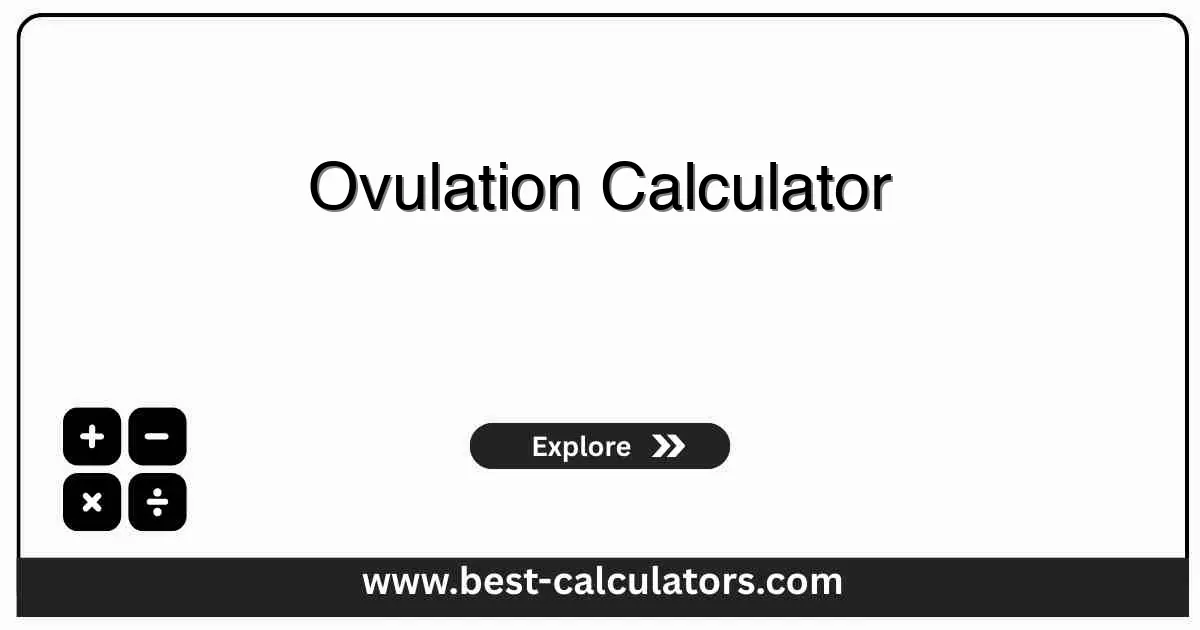Ovulation Calculator - Calculate Fertile Window
Free ovulation calculator to predict ovulation date and fertile window for conception planning based on menstrual cycle length
Ovulation Calculator
Results
What is an Ovulation Calculator?
An Ovulation Calculator is a free fertility tool that predicts your ovulation date and fertile window based on menstrual cycle length and last period date. It calculates the most fertile days for conception using the standard ovulation timing of 14 days before the next period, helping couples plan pregnancy effectively.
This calculator works for:
- Trying to conceive - Identify optimal days for intercourse
- Natural family planning - Track fertility awareness method
- Cycle tracking - Understand menstrual cycle patterns
- Fertility awareness - Learn about reproductive health
To calculate conception date from due date, check out our Conception Calculator to determine when conception likely occurred during your fertile window.
For tracking pregnancy progress, explore our Pregnancy Calculator to calculate due date, current week, and trimester based on conception or last period.
To monitor menstrual cycle, use our Period Calculator to predict next period date and track cycle regularity for fertility planning.
For complete pregnancy planning, try our Pregnancy Due Date Calculator to estimate delivery date and important pregnancy milestones.
How Ovulation Calculator Works
The calculation uses the standard ovulation formula:
Key calculations include:
- Ovulation Date = Last Period + (Cycle Length - 14)
- Fertile Window Start = Ovulation Date - 5 days
- Fertile Window End = Ovulation Date
- Next Period = Last Period + Cycle Length
The fertile window spans 6 days because sperm can survive up to 5 days in the female reproductive tract. The egg survives 12-24 hours after ovulation. Intercourse during this window maximizes conception chances, with highest probability on the 2 days before ovulation.
Key Concepts Explained
Ovulation
Release of a mature egg from the ovary, occurring mid-cycle. The egg travels through fallopian tube where fertilization occurs if sperm present.
Fertile Window
The 6-day period when pregnancy is possible. Includes 5 days before ovulation plus ovulation day. Peak fertility is 2 days before ovulation.
LH Surge
Luteinizing hormone spike 24-36 hours before ovulation. Detected by ovulation predictor kits for precise timing of fertile window.
Cervical Mucus
Changes throughout cycle. Becomes clear, stretchy, and egg-white consistency during fertile window, facilitating sperm transport.
How to Use This Calculator
Enter Last Period Date
Select the first day of your most recent menstrual period from the calendar picker.
Input Cycle Length
Enter your average cycle length in days (typically 21-35 days, average 28 days).
Calculate Results
Click Calculate to see ovulation date, fertile window, and next period prediction.
Plan Accordingly
Use fertile window dates to time intercourse for conception or avoid for natural family planning.
Benefits of Using This Calculator
- • Maximize Conception Chances: Identify the 6-day fertile window when pregnancy is most likely to occur.
- • Natural Family Planning: Track fertility for contraception using fertility awareness methods.
- • Understand Your Cycle: Learn menstrual cycle patterns and predict period dates accurately.
- • Time Intercourse: Plan intimate moments during peak fertility for best conception results.
- • Track Irregularities: Monitor cycle variations that may indicate hormonal imbalances or health issues.
- • Free and Private: Calculate ovulation instantly without sharing personal health information.
Factors That Affect Your Results
1. Cycle Regularity
Calculator accuracy depends on consistent cycle length. Irregular cycles require additional tracking methods like ovulation tests or basal temperature.
2. Stress and Lifestyle
High stress, travel, illness, or significant weight changes can delay or advance ovulation, affecting predictions.
3. Age and Hormones
Perimenopause, PCOS, thyroid disorders, or hormonal imbalances can cause irregular ovulation and unpredictable cycles.
4. Recent Birth Control
After stopping hormonal contraception, cycles may be irregular for several months while hormones normalize.
5. Individual Variation
Some women ovulate earlier or later than day 14 before period. Combine calculator with physical signs for accuracy.

Frequently Asked Questions (FAQ)
Q: When do I ovulate?
A: Ovulation typically occurs 14 days before your next period starts. For a 28-day cycle, ovulation happens around day 14. For a 30-day cycle, it occurs around day 16. Track your cycle length for accurate predictions.
Q: What is the fertile window?
A: The fertile window is the 6-day period ending on ovulation day. This includes the 5 days before ovulation and ovulation day itself. Sperm can survive up to 5 days, making these days optimal for conception.
Q: How accurate is an ovulation calculator?
A: Ovulation calculators are 80-90% accurate for women with regular cycles. Accuracy decreases with irregular cycles. Combine with ovulation tests, basal body temperature tracking, or cervical mucus monitoring for best results.
Q: Can I get pregnant outside the fertile window?
A: Pregnancy is unlikely but possible outside the fertile window due to cycle variations. Sperm can survive up to 5 days, and ovulation timing can shift. Use contraception consistently if avoiding pregnancy.
Q: What are signs of ovulation?
A: Ovulation signs include increased cervical mucus (clear and stretchy), mild pelvic pain (mittelschmerz), breast tenderness, increased libido, and slight temperature rise. Ovulation predictor kits detect LH surge 24-36 hours before ovulation.